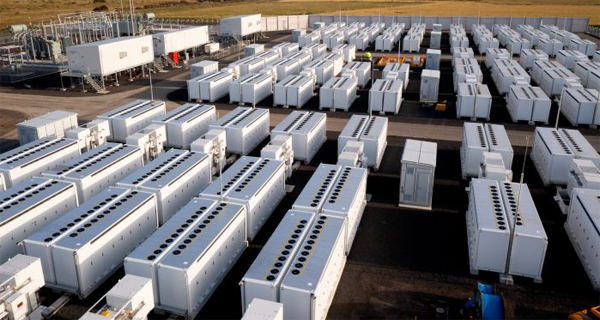Council opposes largest battery energy storage system; will consider staff report on smaller sites
Administrator | Jan 11, 2023 | Comments 7
By Sharon Harrison

The BESS facility in Victoria, Australia is comparable in size to the BESS proposed for County Road 5, Picton. – Victoria State Government photo
The largest of three proposed battery energy storage systems (BESS) for Prince Edward County did not receive support from council Tuesday evening. However, it will consider a staff report for the two smaller Mowbray Road sites.
Known as Picton BESS, the 250 megawatt facility was proposed for County Road 5 by Compass Energy Consulting.
Councillor Bill Roberts put forward an amending motion to have the project denied, something council supported.
“I am opposed to the use of prime agricultural land for this purpose, and we heard some pretty convincing and alerting information from comments from the audience today,” Roberts said.
“I don’t think it’s a fair trade for 15 acres of shipping containers, 250 HVAC systems and strong lights that will keep folks awake; the potential fire risks, I find compelling.”
No decision was made on the two other, much smaller (three megawatts each) battery energy storage system sites on Mowbray Road (known as Athol BESS), by Abundant Solar Energy.
However, council voted to receive a staff report for the two Mowbray Road sites proposed by Abundant Solar Energy, to include information from the fire department, as well as other municipal departments.
The report is expected to come back to council for the Jan. 25 special council meeting.
Council heard presentations from both Compass Energy Consulting and Abundant Solar Energy Inc. on their individual proposals for battery energy storage systems (BESS), hoping to garner municipal support of their participation in the provincial Independent Electricity System Operator RFP for the “Procurement of Expedited Long-Term Electricity Reliability Services.”
Members of the public, 13 in all, had plenty to say on the proposed BESS sites, with all but two audience members voicing objection to the projects, specifically Picton BESS.
Concerns centred around fire and explosion risk, toxicity implications in the event of fire, environmental damage and contamination to wildlife and waterways, groundwater and wells, as well as the vast amount of water required in the event of a fire.
There was also general concern of using lithium-ion batteries (as opposed to other, safer battery technologies).
Some folks were also concerned about the use of prime agricultural being surrendered for the project (in the case of Picton BESS), decreased property values, increased insurance costs, noise concerns from running 200 to 250 HVAC units, and the relatively new, and unknown, nature of BESS.
Sixteen pro-forma letters of support for the Picton BESS project were received from members of the public residing on County Road 5, Fry Road, County Road 34, Fish Lake Road and Bethel Road, as well as a Napanee resident.
A deputation by County resident Angus Ross expressed concern over safety issues specifically relating to the fire risk of BESS and associated environmental risks, such as potential contamination of East Lake from the two Abundant Solar Energy proposed sites on Mowbray Road.
He asked where the constant water supply to be used to put out any fires would come from, citing the public meeting for the Compass Energy Consulting’s proposed BESS on County Road 5.
“We were told that sufficient water would be kept on site to extinguish any blaze. Stored water in the County in January, February or March? I wasn’t aware that ice was an effective fire suppressant,” stated Ross.
He asked, if there is a fire at any of the three proposed locations and water is used as a suppressant, where will the toxic-infused water go? Ross raised concerns over polluting adjoined farmland, especially as it relates to the County Road 5 site.
“Would it leach into aquifers and threaten local wells, and how far would toxic fumes travel and what evacuations would be necessary, and who would pay for the dislocation?” he asked
“For the two sites off Mowbray Road, it could easily get into the streams leading to East Lake; how much would it cost to clean up East Lake?”
Ross also noted the number of BESS installation around the world, and the number of problems encountered in what is a relatively new technology where he cites the failure event database for BESS records no less than 50 fire events since August 2017.
“One of the worst occurred in July 2021 at a 300 megawatt system in Australia and it took 150 firefighters three days to extinguish it while toxic fumes emanated from the system,” noted Ross (noting the BESS proposal for County Road 5 is 250 megawatts).”
“A fire and explosion at a two megawatt installation in Arizona –smaller than any of the installations proposed for the County– severely injured nine responders.”
Ross also addressed finance and liability, CO2 reduction, and the so-called benefits to the County.
Meg Kerr quoted Sandra Kennedy, the commissioner for Arizona’s utility regulator, who was tasked with investigating the safety of BESS technology following a string of BESS incidents in Arizona.
“The first was a fire at a BESS facility, the Eldon sub-station, and the second was a near-miss incident at that same sub-station, and the third was an explosive fire at a two megawatt facility (the McMicken sub-station) that injured eight firefighters, one of whom was thrown 75 feet.”
Kerr continued, “Kennedy said these types of lithium-ion batteries, the same type proposed for the Picton BESS, but of a scale of over 100 times larger than the McMicken sub-station, are ‘not prudent and create unacceptable risks’.”
Kennedy also noted, according to Kerr, that “the explosive potential of a 250 megawatt facility, the size proposed for the Picton BESS, would be equal to 250 tonnes of TNT – for context that’s the same amount detonated at the Halifax explosion.”
Don Wilford noted how lithium-ion batteries are susceptible to fire, and suggested an alternative zinc-based technology that uses aqueous (water) electrolytes, so there is no danger of fire.
“At the scale proposed, the fire would cause vast damage to wetlands, a toxic gas plume requiring evacuation procedures for Picton, and potential loss of firefighters’ lives,” said Wilford.
He said the scale of what is being proposed is truly immense.
“The Picton facility will be 250 megawatts, equivalent to a small modular nuclear reactor,” he said. “Ontario simply does not have the experience of 250 megawatts, or 750 megawatt hours if it’s designed for three-hour capacity – that is the equivalent of not 250 tonnes of TNT, but 650 tonnes of TNT.”
The potential for disaster, if something were to go awry, such as a fire, was Aaron Miller’s concern.
“The municipality is simply not equipped to combat this and it would put tremendous strain on our local fire department, in addition to putting those fire fighters at risk,“ said Miller.
He was also concerned, in the event of a fire, the noxious gases that may be released into the groundwater.
“Having a creek in our backyard that flows directly from this area, we are concerned what would leach into our well water.”
He said, “this project is potentially a huge risk to residents, protected woodlots and working agricultural lands; I don’t think this is the legacy Prince Edward County wants to stand behind.”
Ross Gower noted Official Plan requirements will not be met for the County Road 5 BESS, especially as it pertains to the use of prime agricultural land. He also commented on the massive scale of the project.
He said, “the IESO (Independent Electricity System Operator) ranked 356 potential connection sites across Ontario, among those 166 are ranked higher than the Picton site, and 190 are ranked equally.
“The developers indicate the province is seeking a minimum of 1,500 megawatts of energy storage,” explained Gower. “Based on those numbers, a 250 megawatt BESS, as proposed, would constitute 17 percent of the entire provincial ask, but the County represents 0.2 percent of Ontario’s population. If energy storage were allocated based on population, the entire County would host only 2.5 megawatts.”
Gary Mooney noted how BESS installations, which are quite new worldwide, are subject to significant fire and explosion and toxic chemical risks.
He also voiced concern over the proponents having no experience in operating BESS projects.
“The Picton BESS installation would be the third largest worldwide power outlet, and the second largest worldwide in storage capacity: this is a monster project,” Mooney said.
In his deputation to council, Jonathan Cheszes, president of Compass Energy Consulting, the proponent for Picton BESS, said they are hearing a lot of concerns from community members.
“A lot of it is conjecture unfortunately, and also talking about catastrophes that just don’t reflect the record the battery energy projects operating in this province.”
He said Ontario has a history of operating battery energy storage projects since 2014.
“Notably, there are none of the fires, explosions, toxic plumes that have occurred in Ontario for battery storage projects built here that we have just heard about from a number of speakers.”
Cheszes also said Picton BESS is not going to be one of the biggest projects when it is finished.
“It is up to 250 megawatts, it could be smaller and it is something we are open to talking about,” he said.
He still maintains it will bring significant investment to the area.
“It will bring economic benefits, tax benefits and local employment,” he said.
Cheszes indicated they have talked with Fire Chief Brown a number of times.
“We have had discussions with them and they are not concerned where we are putting this battery storage project,” said Cheszes.
He said the project is being located where it is to take advantage of other existing features on the property.
“There is a 230 kilovolt high-voltage transmission line that goes over this prime agricultural land that connects into a transformer station that is adjacent to a 100-acre solar farm, which is also located on prime agricultural land,” he explained.
“We didn’t pick this place because we have a penchant to disrupt local residents, we picked it because it is adjacent to existing infrastructure and makes the most sense to put it in the County.”
He said it is also close to other industrial activity, such as the quarry and the cement plant.
John Kozak spoke for Abundant Solar Energy Inc’s two projects, each three megawatts in size, one located on the west side of Mowbray Road (north side of Miller Road), the other on the east side of Mowbray Road.
Kozak noted both sites are approximately one-fifth acre and were zoned soil class six, which is non-agricultural.
Each site would accommodate three shipping containers 40-feet in size with a BESS footprint of about 2,000 square foot.
“The electricity from these projects will benefit members of the County only,” Kozak noted
If approved, the Athol BESS facility will be operational in May 2025.
Councillor Phil St-Jean asked if Abundant Solar Energy would commit to not using lithium-ion, and maybe look at alternatives.
“Our intent right now is to use lithium phosphate batteries as they are more dense, safer, and they last longer,” said Kozak.
Andrew Van Doom added they manage thermal run-off much better.
St-Jean wanted a commitment to use a non-lithium-based battery system that has zero or almost zero risk, similar to sodium-ion or zinc-ion batteries. Abundant Solar Energy said they can consider it, but cannot commit to that.
Councillor Sam Branderhorst asked about the level of consultation with the fire department to date.
“I’ve heard from multiple people in my ward speaking of their fear specifically toward fire safety, hearing about how much water is needed for this system,” Branderhorst said. “If the fire chief said they could handle it, who foots the bill for the new equipment and the training,” she said, adding, “I’m hesitant to move forward.”
Kozak said they haven’t had any consultations with fire department, as yet.
“We will put together a first responders plan in conjunction with the fire department and work with them prior to construction.”
Councillor Sam Grosso asked how many HVAC systems would be installed in the Picton BESS facility where Cheszes said for each 40-foot container, there would be 200 to 250 HVAC systems.
Councillor Bill Roberts acknowledged how the two BESS proposals are quite different.
“Abundant is looking to energy meant to serve the local community, it’s smaller in size, it makes for a less dangerous installation, and the site as proposed is on non-agricultural land,” Roberts said.
He went on to say there remain serious concerns from much of the community, genuine worries regarding fire and the risks related with environmental mishap and incident.
“We still don’t really understand how we answer the question about rigorous fire suppression, the training and related costs, special equipment that might be required, some doubts about insurance and liability, plus we are hearing an awful lot about an awful lot of water.”
Filed Under: Local News
About the Author:

































Well kinda like County Rd 49. The local taxpayers will decommission the former highway. Having said that the Mowbray project does bring power backup locally.
A question that no one has asked is: who is going to pay to decommission these sites at the end of their life span? Alberta taxpayers are on the hook for $1.4B to decommission abandoned oil wells. What guarantees do we have that the owners will not just disappear when it comes to paying to have them removed?
The Mowbray storage project will provide power directly for local consumption during peak need times.
Scary thing is they do not need councils approval to do these projects. As long as the province approves it, its a go.
Mowbray is a smaller scale and has access to transmission.
Living less than 1 km from a proposed site on Mowbray Road and after reading the concerns expressed in this article, I am strongly opposed to a system of this type being constructed so close to our home. Not to mention 6 other homes including a group home which are closer to the site than we are. More research needs to be done to convince me that this is appropriate for Prince Edward County in any area. I cannot imagine any volunteer firefighter thinking this is a good idea in an area that is reliant on well water.
When I first read about opposition to this BESS facility I thought here we go again with a group of NIMBYs. After some admittedly brief research, it appears that Lithium-ion batteries come with safety issues. Research is ongoing to find a replacement technology that is safer and more economical. So thank you to those individuals who made their opposition known and thank you to Council for refusing to approve this project.